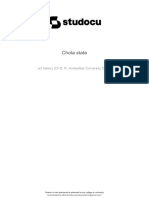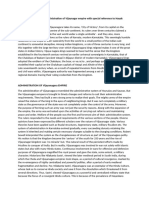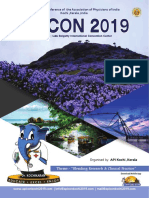Chola State
Chola State
Uploaded by
KanishkaCopyright:
Available Formats
Chola State
Chola State
Uploaded by
KanishkaCopyright
Available Formats
Share this document
Did you find this document useful?
Is this content inappropriate?
Copyright:
Available Formats
Chola State
Chola State
Uploaded by
KanishkaCopyright:
Available Formats
lOMoARcPSD|43769710
Chola state
art history (Dr B. R. Ambedkar University Delhi)
Scan to open on Studocu
Studocu is not sponsored or endorsed by any college or university
Downloaded by Saraswati (darkacademiagirl9@gmail.com)
lOMoARcPSD|43769710
The Cholas were a major political dynasty in South India in the early medieval period. Their rise to power can be traced
to the ninth century CE. The fall of the Pallavas created a power vacuum in the Tamil country, resulting in the rise of
the Cholas. The Chola state stood on a firm footing deriving sustenance from the resource-pocket located in the fertile
and rich area of the Kaveri valley. The characteristics of the early medieval period of the south Indian state is defined
differently by various scholars of distinct schools based on conceptual models. The debate’s major issues include the
degree of control (central authority versus local autonomy) and the various roles of religious institutions in the polity.
The important contributing models are that of the Imperial State model by K.N. Sastri, Marxist’s Indian Feudalism
Model of R. S. Sharma and the Segmentary State Model of Burton Stein. The Integrative State Model of B. D.
Chattopadhyaya is also one of the dominant models that have tried to determine the nature of the state in the early
medieval India.
The writings of pioneering scholars like Nilkantha Sastri marked a significant effort in bringing the dispersed
information from various sources together into a bigger historical narrative. He portrayed the chola monarchy as a
highly bureaucratized, centralised empire with a clear hierarchy that facilitated control even across the large and
diverse geographic area that was under the Cholas' reign.
The chola state was able to strike a balance between centralised bureaucracy and engaged local government, fostering
a strong feeling of civic duty and unprecedented levels of efficiency. Sastri was likewise ready to recognise Vijayanagar
as a chola state where the ruler was also the military commander in addition to being the king. Sastri does discuss the
divisions of the Nadu and the Nadus that make up Vallanadu, but he essentially returns to the point that all of these
territorial subdivisions were ultimately governed by the sort due to the strong centralization of power. Later, T.V.
Mahalingam and A. Appadorai continued along the same lines.
The second state model, Feudalism model , was developed by R.S. Sharma and his adherents, including D.N. Jha, B.N.S.
Yadav, and R.N. Nandi. It focuses on the production relationships within the fief and the decline of trade during the
mediaeval era. Sharma contends that the land concessions made to Brahmans, religious organisations, and
government officials, who were then given the legal and tax-free ownership rights, were a crucial factor in the
development of feudalism in India. Village community lands were invaded, and these inhabitants were gradually
subjugated to serfdom. A decline in urbanisation and trade contributed to and made this situation worse.
Politically, this growth was characterised by a persistent decentralisation and fragmentation process brought on by
the common practise of allocating areas to vassals and officials who later established themselves as autonomous
potentates. Socially, this time period was characterised by the emergence of new castes and the progressive decline
in the social and economic standing of Vaishyas and Shudras. The Kshatriyas and Brahmins gradually resembled the
feudal lords of Europe, while these two Varnas became indistinguishable from one another.
According to the Indian Feudalism Model, which D. C. Sirkar criticises, Brahmins in India carried out similar duties to
military officials in Europe but did so in a different way. Brahmins thus gave their monarchs legitimacy in
a number of ways.
The Segmentary State is an anthropological model developed by Southall. Burton Stein utilized this model to describe
the state formation under the Cholas and the Pallavas. Southall describes the Segmentary State as a state where the
spheres of ritual suzerainty and political sovereignty do not coincide. The former extends widely towards a flexible
changing periphery. The latter is confined to the central core domain. Stein divided into 3 zone- centre, intermediate
and peripheral.
In this theory, the king as having enjoyed only limited territorial sovereignty. The element of centrality existed only in
the core area even where the presence of semi-autonomous foci of administration was tolerated by the Cholas. He
had no political authority over the surrounding segments. The real foci of power are suggested to have been the
locality level centres or Nadus. He also denied the existence of a Chola standing army, arguing that military power was
distributed among various groups including peasants, merchants and artisans
Southall criticized the points of Stein’s denial of the king’s political authority over segments other than his own.
According to him, a king has political authority was combined with his ritual authority in the case of Hindu Kingdoms.
For e.g.the temple of Rajarajeshwara shows his own greatness and the unchallenged prestige of the state by building
this temple.
Downloaded by Saraswati (darkacademiagirl9@gmail.com)
lOMoARcPSD|43769710
It depicts the ritual sovereignty of the king over the whole country. Rajaraja granted to the temple state revenue
accruing from as many as 40 villages in Chola mandalam, the core area of the state and 16 villages in the conquered
area (Karnataka, Sri Lanka). It shows also well-developed bureaucracy for revenue collection. The various departments
called puravwari comprised various offices, functions and feature. They invoked the Siva cult by constructing temples
across the region
He view that the peasant society of the Cholas, which was presented as united structured one, on the primary bonds
being those of kingship and marriage, was in effect an extremely stratified society, vertically divided into numerous
segments. These segments created a highly pyramidal which encourage the series of relationships between the centre
and the peripheries. Each of these segments had a specialised administrative staff. It also had a large amount of
centres, and all the features of a dual sovereignty consisting of political as well as ritual sovereignty.
Stein distinguishes sharply between actual political control on one side and ritual sovereignty on the other. All the
centres of the segmentary state do exercise actual political control over their own parts or segmentary but only one
centre of extending ritual sovereignty beyond its own borders. Stein’s description of the early medieval south Indian
state as a peasant state is even more questionable and seems to represent an extreme reaction to the idea of highly
centralized monarch. The existence of corporate village organizations does not indicate that peasants exercised
political power at a high level.
Hermann Kulke has questioned Stein’s concept of ritual sovereignty. According to him, in a traditional society,
particularly in India, ritual sovereignty seems to be an integral part and sometimes even a pace maker of political
power. These inscriptions were documents of a systematic ritual policy which was as much a part of the general “power
policy” as for instance, economic or military policies.
Another model proposed by B.D. Chattopadhyaya was called the integrated polity model. In this model, he interprets
the early medieval period as a ‘period of state formation’ not disintegration. It means the transformation of pre-state
polities into state polities, thus the integration of local polities.
This integrative development was based on and accompanied by a series of processes like peasantization the
emergence and spatial extending of ruling lineages by processes called Kshatriyaisation; interspersing the dynastic
domain and its hinterlands with network of royally patronized religious institutions and land assignments to officials,
etc.. Moreover, state formation implies that there was an existence of resources capable of generating surplus.
Chattopadhyaya further argues that while land grants were important in country, they did not represent a complete
breakdown of imperial authority. He further argued that land-grants gave too much importance under the Indian
Feudalism model while other factors such as the frequent invasions and continuing authority of the kings had been
ignored.
According to Hermann Kulke, The multiplicity of local and regional power is the result of the extension of monarchical
state society into areas and communities tribal, non-monarchical polity.
Noboru Karashima and Kesavan Veluthat have attempted an alternative model for understanding the nature of the
Chola state. They have attempted a systematic application of the idea of feudalism to the socio-economic formation
in the early medieval period in south India and have called it a “Feudal State”. The research of Karashima indicates
that several titles in Chola inscriptions refer to administrative offices and that the Chola kings made certain attempts
to centralized their administration.
James Heitzman and Y. Subbarayalu preferred to call the Chola state an ‘Early State’. According to this model, the
Chola state was a centralised socio-political organisation, in a complex stratified and extremely unequal society, which
consisted of the rulers and the ruled. Heitzman says that royal political unification took place under the Cholas. The
Chola kings remained ritual leaders but aspired to be managers in the Arthashastra style.
Heitzman says that the success of royal integrative policies depended on local variables of geography. The most striking
feature of the Chola rule was the rapid decline of royal influence with increasing trend towards decentralized. James
Heitzman elaborates that the underlying dynamics of state formation rested on the ability of these agencies to give
direction to the aspirations of the village elite. Political and economic leadership, within a predominantly agrarian
economy, rested on the possession of land or came from control exercised over profits accruing from land. Heitzman
Downloaded by Saraswati (darkacademiagirl9@gmail.com)
lOMoARcPSD|43769710
the Chola polity was an ‘Early State’ since its agrarian base and the political power of its landed elite were at a rather
nascent stage of development. For Subbarayalu the chola state was was an evolutionary state that at a time being
was a centralized. For him, before 985 it was a formative state that was kind of suppressed by other political power of
the region ; from 985-1070 was the period of expansion when chiefdoms started disappearing and new officers came
in and the land holding class emerged ; then came the period of revival from 1070-1178. After reaching a point of
prosperity ,the state gradually started from 1178-1278. So according to him there’s no single way to characterise the
kind of polity that existed in chola state .The argument of Subbarayalu appears more accurate, and the Chola state
was integrated in the middle phase and it perhaps showed somewhat “segmentary nature” in the early
and later phases.
Downloaded by Saraswati (darkacademiagirl9@gmail.com)
You might also like
- Writing Thesis StatementsDocument2 pagesWriting Thesis StatementsChe Wan Nur SyazlyanaNo ratings yet
- Ogl260 Hilton Hotels Stakeholder AnalysisDocument2 pagesOgl260 Hilton Hotels Stakeholder Analysisapi-6296958670% (1)
- Activate Fiori Apps - Analytical ReportsDocument14 pagesActivate Fiori Apps - Analytical ReportsRodrigue EfilaNo ratings yet
- Chola StateDocument4 pagesChola StateMitali PandeyNo ratings yet
- Nature of The Chola State PDFDocument4 pagesNature of The Chola State PDFNainaNo ratings yet
- Nature of The Chola StateDocument5 pagesNature of The Chola StateArchita JainNo ratings yet
- Nature of Chola State - Docx PresentationDocument8 pagesNature of Chola State - Docx Presentationpriyanka100% (7)
- nature-of-chola-stateDocument3 pagesnature-of-chola-stateBholu BurmanNo ratings yet
- The Chola's Were The Most Dominant Rulers in South India in The Early Medieval Period From 9th-13th CenturyDocument4 pagesThe Chola's Were The Most Dominant Rulers in South India in The Early Medieval Period From 9th-13th Centurytanushkapuri2005No ratings yet
- Cholas - Theory On Nature of StateDocument8 pagesCholas - Theory On Nature of StateKundan100% (1)
- The Nature of State in Medieval South IndiaDocument11 pagesThe Nature of State in Medieval South IndiaamyNo ratings yet
- Chola State FormationDocument5 pagesChola State Formationnamrayamin9650No ratings yet
- Imp Chola NatureDocument13 pagesImp Chola NatureGunjan MadanNo ratings yet
- The Chola State PDFDocument8 pagesThe Chola State PDFMuskaan RathoreNo ratings yet
- SEMINAR- SEGMENTARY MODEL OF STATE SUSAN NEWIN II MA HISTORY.-1Document5 pagesSEMINAR- SEGMENTARY MODEL OF STATE SUSAN NEWIN II MA HISTORY.-1hariharabukka2255No ratings yet
- Hoi 3Document6 pagesHoi 3Aditya SinghNo ratings yet
- The Nature of The Indian States of The Early Medieval PeriodDocument4 pagesThe Nature of The Indian States of The Early Medieval PeriodKundanNo ratings yet
- Ramakrishna Mission, Vidyamandira, Belur MathDocument15 pagesRamakrishna Mission, Vidyamandira, Belur MathABDoesThingsNo ratings yet
- State Formation in Early Medieval IndiaDocument12 pagesState Formation in Early Medieval Indiaaditillb22103No ratings yet
- Was Chola Kingdom A Centralized Empire?Document2 pagesWas Chola Kingdom A Centralized Empire?Ramita UdayashankarNo ratings yet
- Chapter - 1Document15 pagesChapter - 1NILESH KUMARNo ratings yet
- Nature of State of Early Medieval India PDFDocument7 pagesNature of State of Early Medieval India PDFNitu KundraNo ratings yet
- Unit 7 Early Medieval Polities in Peninsular India 8 TO 12 Centuries A.DDocument12 pagesUnit 7 Early Medieval Polities in Peninsular India 8 TO 12 Centuries A.DPavan KalyanNo ratings yet
- INTRODUCTIONDocument11 pagesINTRODUCTIONSwastik ShettyNo ratings yet
- Ignou HoiiiDocument17 pagesIgnou HoiiiKomal SahaniNo ratings yet
- Heitzman 1987 State Formation in South India 850 1280Document27 pagesHeitzman 1987 State Formation in South India 850 1280Tanushikha SangwanNo ratings yet
- Authority of The Padshahs in 16th Century Mughal IndiaDocument28 pagesAuthority of The Padshahs in 16th Century Mughal IndiaaupaupyNo ratings yet
- Mhi 04Document8 pagesMhi 04NavyaNo ratings yet
- Transformations: Comparative S of Social TransformationsDocument41 pagesTransformations: Comparative S of Social Transformationstech freekNo ratings yet
- Mhi 04 Block 02Document54 pagesMhi 04 Block 02arjav jainNo ratings yet
- Kautilya Public AdministrationDocument2 pagesKautilya Public Administrationbansal100% (1)
- Evoulution Piblic AdmDocument45 pagesEvoulution Piblic AdmMohamad FaizanNo ratings yet
- Hermann KulkeDocument1 pageHermann KulkeNainaNo ratings yet
- Chola Administration Polity Nature of PolityDocument4 pagesChola Administration Polity Nature of PolityAayushi DahiyaNo ratings yet
- Ancient Indian Political Thought: Unit IDocument18 pagesAncient Indian Political Thought: Unit IFarah ShaheryarNo ratings yet
- Chola AdministrationnDocument10 pagesChola AdministrationnWe TrendsNo ratings yet
- Unit 1Document8 pagesUnit 1Augustine First LadyNo ratings yet
- Early Medieval Period A Distinctive PhasDocument3 pagesEarly Medieval Period A Distinctive Phasmama thakurNo ratings yet
- Indian History Congress Proceedings of The Indian History CongressDocument12 pagesIndian History Congress Proceedings of The Indian History CongressankitNo ratings yet
- Evolution of Political Structures North IndiaDocument15 pagesEvolution of Political Structures North IndiaLallan SinghNo ratings yet
- Modern Asian StudiesDocument41 pagesModern Asian StudiesAkshitaNo ratings yet
- IGNOU Social and Political Thoughts (MPSE-004)Document188 pagesIGNOU Social and Political Thoughts (MPSE-004)Dharma GnaniNo ratings yet
- BSS 311 Notes (Examopedia)Document43 pagesBSS 311 Notes (Examopedia)chikujais7570No ratings yet
- The Role and Character of The Ruling Elite and The Ongoing Conflict Between The Crown and The Nobility During The Sultanate PeriodDocument9 pagesThe Role and Character of The Ruling Elite and The Ongoing Conflict Between The Crown and The Nobility During The Sultanate PeriodAnanyaNo ratings yet
- Mauryan State and EmpireDocument19 pagesMauryan State and EmpireAnmol ArshnaNo ratings yet
- Rajput KingdomDocument4 pagesRajput KingdomRamita Udayashankar88% (8)
- Unit 1 KNC502Document17 pagesUnit 1 KNC502nasirhussain95343No ratings yet
- Archipel Bureaucracy and Aristocracy. The Indonesian Experience in The XLXTH Century - Sartono KartodirdjoDocument19 pagesArchipel Bureaucracy and Aristocracy. The Indonesian Experience in The XLXTH Century - Sartono KartodirdjoEstefanía BarrionuevoNo ratings yet
- Sudipta Kaviraj-Trajectories of The Indian State - Politics and Ideas-Orient Blackswan (2010)Document145 pagesSudipta Kaviraj-Trajectories of The Indian State - Politics and Ideas-Orient Blackswan (2010)mohdaquil100% (2)
- State Formation in South India 850 1280 Heitzman PDFDocument28 pagesState Formation in South India 850 1280 Heitzman PDFReshu SengarNo ratings yet
- Administration of The Vijayanagara StateDocument15 pagesAdministration of The Vijayanagara Statesmrithi100% (1)
- VijaynagarDocument15 pagesVijaynagarsmrithi100% (1)
- Unit 16Document14 pagesUnit 16LinNo ratings yet
- Block 5Document40 pagesBlock 5junaid khanNo ratings yet
- Feudalism and The Eco, Soc and Pol Changes.Document7 pagesFeudalism and The Eco, Soc and Pol Changes.raisha.galib2014No ratings yet
- history assignmentDocument10 pageshistory assignmentkorakutisaimuktheshNo ratings yet
- Notes Mpse 4Document16 pagesNotes Mpse 4mailyjain.21No ratings yet
- CholasDocument17 pagesCholasAvantika YadavNo ratings yet
- Indian History 3Document23 pagesIndian History 3Pooja EdappayilNo ratings yet
- The Headless State: Aristocratic Orders, Kinship Society, and Misrepresentations of Nomadic Inner AsiaFrom EverandThe Headless State: Aristocratic Orders, Kinship Society, and Misrepresentations of Nomadic Inner AsiaRating: 4 out of 5 stars4/5 (1)
- Intrigue and Ambition: The Political Machinations of the Three Kingdoms: Royal Plots, Diplomatic Maneuvers, and the Fight for Supremacy: The Three Kingdoms Unveiled: A Comprehensive Journey through Ancient China, #3From EverandIntrigue and Ambition: The Political Machinations of the Three Kingdoms: Royal Plots, Diplomatic Maneuvers, and the Fight for Supremacy: The Three Kingdoms Unveiled: A Comprehensive Journey through Ancient China, #3No ratings yet
- Fundamentals of Cost-Volume-Profit Analysis: Mcgraw-Hill/IrwinDocument17 pagesFundamentals of Cost-Volume-Profit Analysis: Mcgraw-Hill/Irwinimran_chaudhryNo ratings yet
- The Attraction of KoreaDocument52 pagesThe Attraction of KoreailiniaNo ratings yet
- Iso 9001 2015 Certificate With Annex 20171228Document14 pagesIso 9001 2015 Certificate With Annex 20171228Delfino NavejuNo ratings yet
- 2022 2023 Oral Com DLLDocument7 pages2022 2023 Oral Com DLLDianne100% (1)
- APICON 2019 Brochure PDFDocument24 pagesAPICON 2019 Brochure PDFrasakatla jaswanthNo ratings yet
- Gerson8e Ppt04-Audience RecognitionDocument27 pagesGerson8e Ppt04-Audience Recognitionapi-262095860No ratings yet
- SSS-TQM-UII 3 Taguchi, Ishikawa, Imai and Shingo PDFDocument6 pagesSSS-TQM-UII 3 Taguchi, Ishikawa, Imai and Shingo PDFதோனி முருகன்No ratings yet
- Admit Card: 26900118034: Maulana Abul Kalam Azad University of Technology, West BengalDocument2 pagesAdmit Card: 26900118034: Maulana Abul Kalam Azad University of Technology, West BengalAshwani GautamNo ratings yet
- History ProjectDocument13 pagesHistory ProjectPriyansbNo ratings yet
- Sociology of GenderDocument18 pagesSociology of Genderahmar atharNo ratings yet
- Read Ahead For Dss Leadership Conf 20110200Document15 pagesRead Ahead For Dss Leadership Conf 20110200Project On Government OversightNo ratings yet
- PALEDocument5 pagesPALEDaryll Gayle AsuncionNo ratings yet
- wph04 01 MSC 20190307Document16 pageswph04 01 MSC 20190307Haroon AslamNo ratings yet
- Cidtt The GuideDocument268 pagesCidtt The GuideAbdul Shameem100% (1)
- 10.2.2.8 Packet Tracer - DHCP and DNS ServersDocument4 pages10.2.2.8 Packet Tracer - DHCP and DNS ServersKe Syukuran Ku100% (1)
- ImmunoglobulinDocument39 pagesImmunoglobulinReguird AllaeinniNo ratings yet
- Short Version ThesisDocument35 pagesShort Version ThesisMogi Tsend-AyushNo ratings yet
- Brine Concentrator PDFDocument4 pagesBrine Concentrator PDFAyush MapariNo ratings yet
- Kill the Sun 621Document8 pagesKill the Sun 621mohanthapa3373No ratings yet
- Ff&e Project Presentation SampleDocument27 pagesFf&e Project Presentation SampleMaghfiroh Nur Aisyah100% (1)
- Cyber Crime: Aimee Payne Cyber Protect & Prevent Officer Serious Economic Crime UnitDocument38 pagesCyber Crime: Aimee Payne Cyber Protect & Prevent Officer Serious Economic Crime UnitEnes BulutNo ratings yet
- Offer Purchase AgreementDocument2 pagesOffer Purchase AgreementAnnika MonariNo ratings yet
- SECTION H Reference Documents Rev MS01Document57 pagesSECTION H Reference Documents Rev MS01DavidNo ratings yet
- Effect of Bacterial Polysaccharide Production On Formation DamageDocument5 pagesEffect of Bacterial Polysaccharide Production On Formation DamageLulut Fitra FalaNo ratings yet
- NSB 180FT Red Battery (SES-542!46!03) NetsphereDocument2 pagesNSB 180FT Red Battery (SES-542!46!03) NetsphereRaul OrtizNo ratings yet
- 4885 CriticalReasoning PDFDocument12 pages4885 CriticalReasoning PDFpushpendra kumar vashishthaNo ratings yet
- Financing Municipal WaterDocument83 pagesFinancing Municipal WaterJohn SmithNo ratings yet

























































































